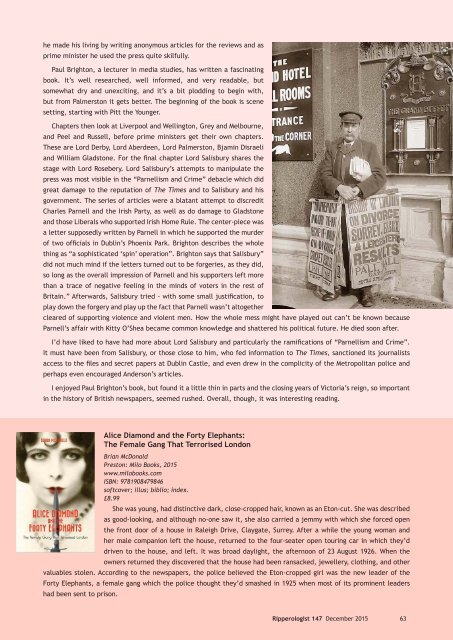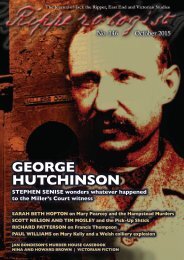Edmund Reid
nuhf574
nuhf574
You also want an ePaper? Increase the reach of your titles
YUMPU automatically turns print PDFs into web optimized ePapers that Google loves.
he made his living by writing anonymous articles for the reviews and as<br />
prime minister he used the press quite skilfully.<br />
Paul Brighton, a lecturer in media studies, has written a fascinating<br />
book. It’s well researched, well informed, and very readable, but<br />
somewhat dry and unexciting, and it’s a bit plodding to begin with,<br />
but from Palmerston it gets better. The beginning of the book is scene<br />
setting, starting with Pitt the Younger.<br />
Chapters then look at Liverpool and Wellington, Grey and Melbourne,<br />
and Peel and Russell, before prime ministers get their own chapters.<br />
These are Lord Derby, Lord Aberdeen, Lord Palmerston, Bjamin Disraeli<br />
and William Gladstone. For the final chapter Lord Salisbury shares the<br />
stage with Lord Rosebery. Lord Salisbury’s attempts to manipulate the<br />
press was most visible in the “Parnellism and Crime” debacle which did<br />
great damage to the reputation of The Times and to Salisbury and his<br />
government. The series of articles were a blatant attempt to discredit<br />
Charles Parnell and the Irish Party, as well as do damage to Gladstone<br />
and those Liberals who supported Irish Home Rule. The center-piece was<br />
a letter supposedly written by Parnell in which he supported the murder<br />
of two officials in Dublin’s Phoenix Park. Brighton describes the whole<br />
thing as “a sophisticated ‘spin’ operation”. Brighton says that Salisbury”<br />
did not much mind if the letters turned out to be forgeries, as they did,<br />
so long as the overall impression of Parnell and his supporters left more<br />
than a trace of negative feeling in the minds of voters in the rest of<br />
Britain.” Afterwards, Salisbury tried - with some small justification, to<br />
play down the forgery and play up the fact that Parnell wasn’t altogether<br />
cleared of supporting violence and violent men. How the whole mess might have played out can’t be known because<br />
Parnell’s affair with Kitty O’Shea became common knowledge and shattered his political future. He died soon after.<br />
I’d have liked to have had more about Lord Salisbury and particularly the ramifications of “Parnellism and Crime”.<br />
It must have been from Salisbury, or those close to him, who fed information to The Times, sanctioned its journalists<br />
access to the files and secret papers at Dublin Castle, and even drew in the complicity of the Metropolitan police and<br />
perhaps even encouraged Anderson’s articles.<br />
I enjoyed Paul Brighton’s book, but found it a little thin in parts and the closing years of Victoria’s reign, so important<br />
in the history of British newspapers, seemed rushed. Overall, though, it was interesting reading.<br />
Alice Diamond and the Forty Elephants:<br />
The Female Gang That Terrorised London<br />
Brian McDonald<br />
Preston: Milo Books, 2015<br />
www.milobooks.com<br />
ISBN: 9781908479846<br />
softcover; illus; biblio; index.<br />
£8.99<br />
She was young, had distinctive dark, close-cropped hair, known as an Eton-cut. She was described<br />
as good-looking, and although no-one saw it, she also carried a jemmy with which she forced open<br />
the front door of a house in Raleigh Drive, Claygate, Surrey. After a while the young woman and<br />
her male companion left the house, returned to the four-seater open touring car in which they’d<br />
driven to the house, and left. It was broad daylight, the afternoon of 23 August 1926. When the<br />
owners returned they discovered that the house had been ransacked, jewellery, clothing, and other<br />
valuables stolen. According to the newspapers, the police believed the Eton-cropped girl was the new leader of the<br />
Forty Elephants, a female gang which the police thought they’d smashed in 1925 when most of its prominent leaders<br />
had been sent to prison.<br />
Ripperologist 147 December 2015 63




